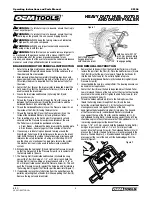
3
Operating Instructions and Parts Manual
25106
8/20
2020 OEMTOOLS
®
HEAVY DUTY HUB, ROTOR
AND DRUM PULLER
WARNING
:
If a ratchet strap is to be used, ensure the strap is
free of any other parts.
WARNING
:
If a ratchet strap is to be used, ensure the strap
does not drag on the ground, this can cause a tripping hazard.
WARNING
:
ALWAYS keep the forcing screw well lubricated,
use a high quality, anti-seize compound.
WARNING
:
ALWAYS use impact sockets and accessories
when using air tools with this tool.
WARNING
:
While this tool can be used to remove larger parts
as mentioned in the purpose section of this manual, OEMTOOLS
®
cannot describe all of the various procedures needed for any
situation, and advise that the user references the vehicle maintenance
manual or contact a qualified technician for assistance.
BRAKE DRUM/ROTOR REMOVAL INSTRUCTION
1. Refer to the vehicle maintenance manual prior to use. Use the
recommended lifting method and device to lift the vehicle so that
the wheel and tire are elevated.
2. After removing the wheel, completely thread two lugs back onto
opposing wheel studs. Back the lug nuts off of the drum 3-4 turns.
This allows the drum to be pulled from the hub, but not fall off of
the studs.
3. Center the T-Bar (B) over the drum or rotor to be pulled. Adjust the
Set Knobs (C) so that the Drum/Rotor Puller Jaws (D) are secured
evenly around the drum/rotor.
4. Grease the two Hardened Washers (H), Forcing Nut (F) and
Pressure Screw (A).
5. Thread the Pressure Screw (A) through the T-Bar (B). Leave room
between the Pressure Screw (A) and the drum/rotor to add the
Hardened Washers (H) and Forcing Nut (F).
6. Thread the Hardened Washers (H) over the Pressure Screw (A), on
the inside of the T-Bar (B) facing the drum/rotor.
7. Thread the Forcing Nut (F) over the Pressure Screw (A), on the
inside of the Hardened Washers (H) facing the drum/rotor.
8. Prior to pulling, ensure the Set Knobs (C) are properly set and
secured, and the Pressure Screw (A) is centered over the axle.
The Puller Jaws (E) should be positioned as follows:
a. Drum Brakes – Between the brake drum and the backing plate.
b. Disc Brakes – Securely against the backside of the rotor.
9. If necessary, a ratchet strap can be used to wrap around the
Drum/Rotor Puller Jaws (D) to better secure the jaws to the drum/
rotor. ALWAYS check the ratchet strap for damage prior to use and
reference the safety instructions if using a ratchet strap. DO NOT
use the strap as a mechanism to apply more force to the system;
this mechanism is only to be used to better clamp around the
system.
10. While holding the Forcing Nut (F), hand tighten the Pressure Screw (A),
so that the male notch in the Pressure Screw (A) is in contact with
the female notch in the axle.
11. The Forcing Nut (F) and Hardened Washers (H) should be snug
against the T-Bar (B). Using a 1-1/4" or 32 mm wrench, hold the
Forcing Nut (F) in place. Using an impact wrench with a 1-1/4" or
32 mm impact rated socket, drive the Pressure Screw (A). This will
push the Pressure Screw (A) against the hub/axle, and by retaining
the Forcing Nut (F) against the T-Bar (B), pull the drum/rotor (Figure 1).
12. If applicable, remove the ratchet strap from the puller. Remove the
puller by adjusting the Set Knobs (C) while supporting the T-Bar (B).
Remove the lug nuts and drum/rotor.
Hold hex nut with 1.25"
or 32 mm wrench while
impacting the drive bolt
to engage pulling
Verify the puller jaw
has good contact
with the brake drum
HUB REMOVAL INSTRUCTION
1. Remove the Set Knobs (C) from the Drum/Rotor Puller Jaws (D) and
remove the jaws from the T-Bar (B). Place the Hub Puller Jaws (E) onto
the T-Bar (B) so that the jaws face inward. Thread the Set Knobs (C)
into the Hub Puller Jaws (E). Do not fully tighten into place.
2. Grease the two Hardened Washers (H), Extended Forcing Nut (G) and
Pressure Screw (A).
3. Inspect behind the hub for a solid platform. The steering knuckle can
be used in most applications.
4. Center the T-Bar (B) over the hub to be pulled. Adjust the Hub Puller
Jaws (E) around the back of the hub, so that they rest on the steering
knuckle or other solid platform. Tighten the Hub Puller Jaws (E) into
place using the Set Knobs (C).
5. Thread the Hardened Washers (H) onto the Forcing Screw, then
thread the Forcing Screw through the T-Bar (B) and the hub.
6. Select the correct Hub Adapter (I, J, K) that will pass through the
steering knuckle and rest against the back of the hub.
7. Hand tighten the Extended Forcing Nut (G) into place. The hex end
of the Pressure Screw (A) and Hardened Washers (H) should be
snug against the top of the T-Bar (B), and the Hub Adapter (I, J, K)
and Extended Forcing Nut (G) should be snug against the hub. There
should be no play in the system; ensure that the Hub Adapter (I, J, K)
is pressing squarely against the back of the hub.
8. Using a 1-1/4" or 32 mm wrench, hold the Extended Forcing Nut (G).
Using an impact wrench with a 1-1/4" or 32 mm impact rated
socket, drive the Pressure Screw (A). The Hardened Washers (H) will
press on the T-Bar (B), the Hub Puller Jaws (E) will press against the
knuckle. The Hub Adapter (I, J, K) and Extended Forcing Nut (G) will
press against the rear of the hub until the hub dislodges from the
knuckle (Figure 2).
Figure 2
Figure 1


























